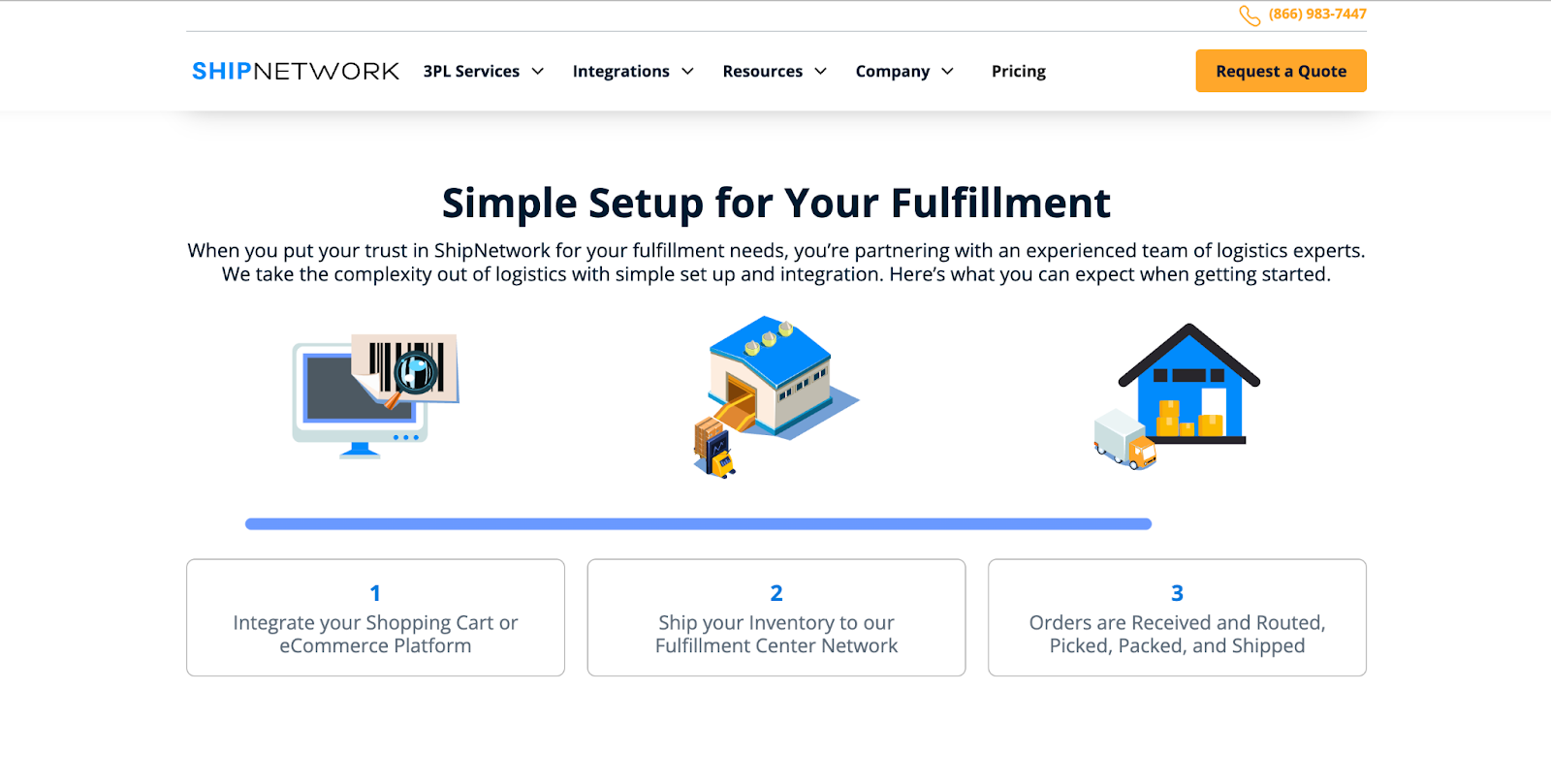When buying products online, people expect their orders to be packaged and shipped as soon as possible. In fact, most customers say that convenience is the main reason they choose to shop online versus in-store.
To efficiently store, pack, and ship products, you need an ecommerce fulfillment strategy. Some businesses choose to fulfill customer orders in house. Others use a fulfillment partner to manage inventory, package orders, and organize delivery.
The best fulfillment solution for you depends on the size of your business and the type of products you sell. This guide covers the basics of ecommerce fulfillment, popular methods, and how to select a fulfillment provider.
What is ecommerce fulfillment?
Ecommerce fulfillment is the process of picking, packing, and shipping online orders to customers. It includes managing inventory, packaging products, and delivery logistics.
Fulfillment companies process orders for multiple online stores. They operate fulfillment centers in strategic locations, storing inventory near cities and transport hubs to reduce delivery times.
How do you fulfill an ecommerce order?
Small sellers typically manage their own orders, while larger businesses use fulfillment companies and other third-party logistics (3PL) solutions to reduce costs. Ecommerce merchants using a dropshipping business model forward the entire fulfillment process to the manufacturer or supplier.
Let’s look at these three fulfillment methods in more detail.
Self-fulfillment
New businesses and those with unique shipping needs often handle their own fulfillment. Using an ecommerce platform like Shopify, shipping orders to customers is a straightforward and accessible task. Small businesses can track orders, handle returns and exchanges, and provide the same delivery service as larger retailers.
In-house order fulfillment may mean managing your own inventory, providing customer support, and employing staff to process orders.
Third-party fulfillment
As order volume increases, most ecommerce businesses can no longer store, pack, and ship their products in house. So, they switch to third-party warehousing or fulfillment solutions. These companies work with merchants to process orders and negotiate lower shipping costs from carriers.
With outsourced fulfillment, the process for ecommerce businesses becomes simpler. In many cases, orders can be sent directly to a fulfillment partner, which will handle packing and shipping. All the retailer needs to do is ensure their fulfillment provider has enough inventory to meet order demands.
The Shopify Fulfillment Network app connects US Shopify stores to trusted third-party fulfillment partners like Flexport for better order management and fast, affordable nationwide delivery.
Dropshipping
Dropshipping is an ecommerce model where merchants aren’t responsible for fulfillment. Instead of producing or storing inventory, a store forwards orders to a manufacturer or distributor, who dropships the product directly to the customer.
This fulfillment method helps online stores establish themselves and avoid upfront costs. But, it can reduce merchants’ control over shipping and customer service, and mean longer delivery times.
8 best ecommerce fulfillment solutions
If you’re looking to work with a fulfillment company, figuring out where to start can be daunting. To help, we’ve compiled a list of seven top ecommerce fulfillment solutions, with the key features you can expect from each.
- Shopify Fulfillment Network
- Flexport
- ShipNetwork
- Fulfillment by Amazon (FBA)
- ShipBob
- Red Stag Fulfillment
- ShipHero
- ShipMonk
1. Shopify Fulfillment Network

Shopify Fulfillment Network (SFN) connects your Shopify store to our trusted logistics partner. When you set up an account, Flexport, our launch partner, will handle packing and delivery, sending orders faster and more reliably than you can do alone.
Here’s how SFN works
- Install the free SFN app.
- Once installed, set up your account with Flexport.
- Send inventory to a single Flexport location for distribution across the fulfillment center network.
- When a customer places an order, Flexport will pack it and manage delivery.
With no minimum inventory requirement, it’s easy to test Flexport with a limited number of products. Estimate your fulfillment and storage costs with this calculator.
Key benefits of SFN
- Monitor everything from your Shopify admin
- Fulfill orders for eligible products from all your connected sales channels, including Amazon, Walmart, and eBay
- Hassle-free inventory shipping to a single location
- Sync Flexport data with your store at no extra cost
2. Flexport
For most Shopify merchants not using SFN, Flexport will provide a great solution.
Flexport coordinates global logistics from factory to the customer’s door—empowering businesses to sell everywhere, ship anywhere and grow. It offers affordable and competitive pricing, and flexible delivery speed options, ensuring you only pay for what your business needs.
Key features
- Two- and three-day delivery
- Ecommerce, DTC and B2B fulfillment
- Demand-based planning brings inventory closer to customers
- International fulfillment with straightforward pricing
- Customs and insurance
- Supply chain financing
Visit Flexport.com to learn more and request a quote.
3. ShipNetwork

For US brands, ShipNetwork boasts 100% next-day shipping across more than 10 fulfillment centers nationwide, ensuring delivery within two days.
Request a quote to learn more about ShipNetwork’s pricing.
Key features
- Order accuracy guarantee
- Subscription fulfillment for selling and distributing subscription boxes
- Return management services for unwanted products
4. Fulfillment by Amazon (FBA)

Brands that do most of their selling on Amazon may decide that the most straightforward process is to have Amazon handle their fulfillment needs.
With Fulfillment by Amazon (FBA), new sellers can access promotions like free shipping to fulfillment centers, storage, liquidations, and return processing.
By sending products to Amazon’s fulfillment centers, you’ll also give your customers the option to ship packages via Amazon Prime two-day shipping.
Amazon’s fulfillment costs are based on the product’s size and weight.
Key features
- 24/7 customer support from the Amazon FBA team
- Inventory performance dashboard to monitor and understand purchase behavior
- Returns management
5. ShipBob

ShipBob is another popular fulfillment solution that’s available as a Shopify integration. It works with both DTC and B2B companies across the globe.
Connect your store to ShipBob’s software, import your product catalog, then send ShipBob your inventory.
Generate a quote to get specific pricing for ShipBob.
Key features
- Omni-fulfillment for customers purchasing across marketplaces (Amazon, eBay, Shopify stores)
- Customizable shipping materials
- Wholesale and dropshipping order fulfillment
6. Red Stag Fulfillment

With its 30-day free trial, Red Stag is a good option for businesses new to third-party ecommerce fulfillment. Red Stag also commits to 100% customer order accuracy and offers same-day fulfillment, ensuring products get on their way to customers as soon as possible.
Key features
- Shopify shopping cart integration
- Warehouse and inventory monitoring
7. ShipHero

ShipHero also has a Shopify app integration. With nine warehouses across the US and Canada, products are distributed throughout fulfillment centers depending on the most common customer locations.
Orders are shipped from the warehouse closest to each customer for faster delivery.
Costs are dependent on package size and shipping method. They range from $5.60 to $87.78 per product. Storage pricing starts at 65¢ per cubic foot.
Key features
- Inventory management system suggests promotions for products that aren’t selling
- In-package snapshots
- PostHero integration tracks packages from warehouse to destination
8. ShipMonk

For international fulfillment, ShipMonk is the only solution on this list with European warehouse locations (in the UK and Czech Republic). There are also warehouses in Canada and Mexico.
Like ShipHero and ShipBob, ShipMonk has a Shopify app integration, so Shopify merchants can link the fulfillment solution directly to their stores.
ShipMonk’s pricing page includes a calculator to estimate your fees.
Key features
- More than 100 integrations let ShipMonk fit into existing business processes
- Transparent billing and reports
- Fulfillment for ecommerce, retail, subscription boxes, crowdfunding, and more
How to choose a fulfillment solutions provider
Here’s what to look for when choosing an ecommerce fulfillment provider for your business.
Similar industry experience
Every fulfillment company functions differently. Many providers package their services for niche businesses or specialist industries. If your business has unique needs, look for a fulfillment partner with experience handling your products and customer base.
Ecommerce specialization
Try to find a logistics company that already works with ecommerce businesses. Prior ecommerce fulfillment experience means your provider can offer strategic guidance as you grow.
Before committing to an agreement, chat with your potential fulfillment partner about the needs of your business. Don’t be afraid to ask questions or request references.
Look beyond price
One of the most common shipping problems is cost. While choosing a fulfillment solution based on budget is tempting, finding a company that’s a good fit is just as important.
Poor fulfillment creates unhappy customers, which can cost more than shipping overheads. As a result, pricing should be one of the factors in your decision-making, but not the only one.
Other factors to consider when choosing an ecommerce fulfillment provider
- Data and analytics: Harnessed correctly, data is a powerful tool in ecommerce. Look for solutions with real-time analytics tracking so you can make informed decisions about inventory allocation.
- Fulfillment center locations: Placing your stock closer to customers will reduce shipping times and costs. You may be able to offer same-day delivery in some circumstances.
- Inventory shrinkage allowance: Some 3PLs charge fees for inventory shrinkage—the term for damaged, stolen, or lost products. Others offer zero shrinkage policies.
Ecommerce fulfillment stages
Every fulfillment company operates differently, but they share the same goal: to prepare and ship orders as efficiently as possible. Many fulfillment centers also double as warehouses for inventory storage, so you can keep more product.
From storing items to packaging products, the ecommerce fulfillment process has many moving parts. Here are the basic stages:
1. Receiving orders and inventory storage
After receiving a customer order, fulfillment centers need quick access to your inventory. To do this, they store products in highly organized warehouses.
Every product is assigned a stock keeping unit (SKU) and has a specific storage location in the warehouse. Fulfillment centers also track inventory levels and work with merchants to keep products in stock.
2. Packing and shipping
Submitted orders are picked and packed for shipping. Many fulfillment centers have agreements with shipping carriers to manage packages in bulk and reduce shipping costs.
The centers then share shipping confirmation and tracking information with merchants or directly with customers.
Most online retailers consider delivery speed to be the most important fulfillment factor for customers. To help packages reach their destinations quickly, some fulfillment providers have centers in multiple locations, allowing them to pre-distribute stock.
If you’re scaling fast and looking to optimize your fulfillment strategy, work with a provider that offers a central view of your data and smart inventory allocation across multiple warehouses.
3. Returns management
In 2023, US online shoppers returned nearly $248 billion worth of products. As more customers expect stores to offer generous return policies, many logistics companies will process returns and issue refunds on your behalf.
Typically, customers will send a return directly to the fulfillment center, where it’s inspected for damage or malfunctions. Some fulfillment providers will replace the product or issue a refund, so retailers may never need to get involved. If the returned product is in sellable condition, they’ll restock and ship it in future orders.
The benefits of using third-party logistics
The advantages of switching to a third-party logistics (3PL) provider go deeper than time and cost savings. These companies are fulfillment experts that can help scale your ecommerce business.
Increased warehouse flexibility
Instead of committing to fixed contracts for warehouse space, many logistics companies offer flexible pricing, adapting to your needs as you grow or go through a slow sales period.
Expert advice
All ecommerce businesses will face supply chain issues at some point. Each 3PL has a team of logistics experts and support staff to help you. They manage the labor required for receiving and managing inventory—giving you a level of agility you might not achieve as easily alone.
Time savings
Chances are you didn’t start a business because you’re good at packing boxes. Your time is better spent on managing your company than the logistics of order fulfillment. When you let someone else take care of logistical details, you can focus on areas where you can have a greater impact on your bottom line.
When is the right time to switch to outsourced fulfillment?
Most companies start by fulfilling their own orders and add a third-party solution as they scale. But when you’re bootstrapping your business, making the decision to partner with another company is hard.
The important thing to remember is that your business doesn’t need to reach a specific size to use a fulfillment solution. If you find yourself in one of the situations below, it could be time to start chatting with a logistics company.
Cyclical or uneven sales
If the number of orders you process fluctuates throughout the year, it may not make sense to commit to running and staffing a warehouse. A fulfillment company will be able to adapt to your needs.
Likewise, unexpected spikes in sales can compromise your delivery promise. An expert can handle times when your daily order volume peaks, so you can maintain a consistent customer experience.
You’re too busy
If you’re so busy dealing with order fulfillment that you don’t have time to focus on growth, it’s probably time to start outsourcing. As a business owner, you need to devote time to marketing, expanding your sales channels, sourcing new products, and otherwise improving your offering.
Lack of infrastructure
Logistical hurdles like increased costs and longer shipping times can limit your ability to expand into new markets. When you outsource to a global fulfillment partner, they can leverage their multiple locations to keep up with customer demand.
Ecommerce fulfillment challenges
No single solution is perfect for every business. There are times when using an ecommerce fulfillment provider doesn’t make sense, no matter the size of your business.
A third-party logistics company may not be the best option for the following types of business:
Businesses with limited cash flow
If extra funds aren’t available, you may need to bootstrap business growth and run your own fulfillment process. For example, during Amazon’s early days, employees would spend their evenings hand-picking and packing customers’ book orders.
Highly specialized businesses
Fulfillment centers may be unable to accommodate customizable products, highly fragile objects, or sensitive materials.
Businesses with limited daily order volume
If you’re only receiving a handful of orders per day, it’s likely too soon to consider outsourcing fulfillment. At this stage, it’s still manageable in-house by yourself or an employee.
When you hit five to 10 shipments per day, it might be time to begin your search for a 3PL.
Moving forward with your ecommerce fulfillment partner
Outsourced ecommerce order fulfillment makes sense for businesses with big goals and fluctuating sales. If you don’t have the time or resources to pack and ship orders in-house, an expert third party can help you optimize your fulfillment process and offer premium customer service.
Ecommerce fulfillment FAQ
What is an order fulfillment process?
An order fulfillment process refers to the steps a business takes to receive and send customer orders. It involves receiving products, storing them in warehouses, picking and packaging, shipping, and logistics.
What is the best fulfillment solution?
For ecommerce merchants, the best fulfillment solution is the Shopify Fulfillment Network, managed through Flexport. With strategically located US distribution centers, Flexport gives online sellers the ability to promise fast shipping to their customers. Transparent pricing covers inventory management and delivery.
How do I fulfill an online order?
- Receive a customer order and process it.
- Package the order.
- Label and ship the order.
- Track the package to its destination.
How much does ecommerce fulfillment cost?
Fulfillment solutions typically charge by the hour, per unit, or per pallet. Providers add up costs for receiving orders, picking and packing, shipping, kitting or bundling, returns, and other services. They may also apply recurring fees for inventory storage.
What is direct order fulfillment?
Direct fulfillment is when a store or manufacturer ships orders directly to customers rather than sending bulk shipments to retailers.







